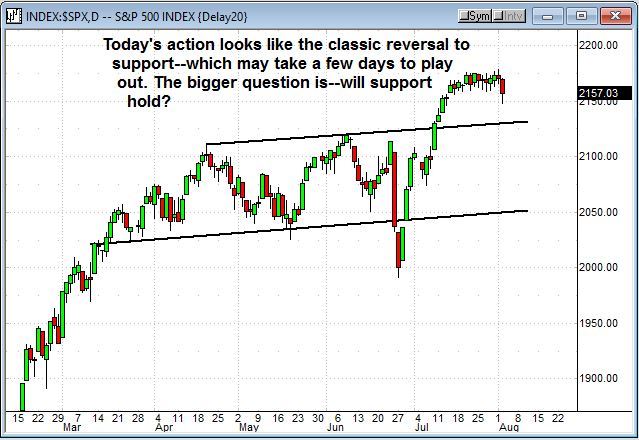Today the SP-500 broke below it's long standing sideways channel prompting some market watchers to wonder if this isn't the start of the traditional late summer slide.
Aside from today's action however this market has been remarkable resiliant–and it's that refusal to breakout that has created some recent short-term victories. We had two SPX trades expire worthless on Friday–an expiration day condor for a 12% gain, and a longer term call spread for 15%.
Those are welcome profits but we also closed out of our IBB call spread earlier in the week at a loss. Losses are always part of trading–we just don't want too many too often–those flurries can be tough on your account. To offset that we're trading a bit more conservatively, building our accounts with set-ups that may yield slightly less, but are easier manage with more reliable results.
And an important part of that is trading in the opposite direction of the trend–so to see where our next profits my be hiding let's first take a look at…
The Markets and How They Affect Us
The SP-500 fell out of its trading range today looking like it wants to run lower…

As you can see from the chart above the SPX finally broke down out of the sideways pattern it's been locked in for the past 3 weeks. Dip buyers stepped in before the close, but the volume on the deline was decent indicating more possible downside.
Today's volume was 7.5 billion shares and the highest since July 12th. Much of that volume was selling, with decliners at 5,499 3:1 over advancers at 1,641.
Today's selloff was sparked by the yen/dollar carry trade. Prime Minister Shinzo Abe announced a $274 billion stimulus program but only $73 billion is actually new direct spending. The 28 trillion yen program is spread out over several years rather than offering an instant jolt to the economy. The Nikkei fell -1.5% on the news as investors were hoping for a more immediate program. This is the 26th stimulus program announced during the current decline in the Japanese economy and a stark reminder that stimulus programs can't carry the economy–all they provide is a temporary boost that without real strengthening fundamentals ultimately fails.
We're starting to see some cracks in our own economy as the loose money in the private sector starts to tighten. More banks are raising standards on commercial and industrial loans now than at any point since the fourth quarter of 2009–just after the Great Recession ended.
Plus more than 8% of lenders raised standards on auto loans this quarter. That was a huge swing from last quarter, when lenders were still making it easier to get car financing. That tightening of loan standards is what likely accounted for the massive miss in auto sales in June. Ford sales fell 2.8%, when a 1.7% drop was expected, while GM sales fell 1.9% when a 1.9% rise was forecast.
Tightening consumer credit is going to rattle an already fragile economy impacting earnings going forward–particulary in the retail sector. But earnings problems aren't new–they've been going on for awhile and unfortunately aren't likely to improve much–at least not for the rest of this year.
At this point Q3, Q4 and full year 2016 expectations have fallen again with the full year 2016 outlook on the verge of turning negative. The 3rd quarter growth estimate has fallen further into negative territory at -0.6% while the 4th quarter outlook is still positive, but it dropped from last week by -0.3%.
Full year 2016 outlook now stands at 0.1% and could easily turn negative as early as next week. The second quarter now marks the 5th quarter in a row of negative earnings and the 6th quarter of negative revenue growth. Over the past half-century, we have never seen a decline in earnings of this magnitude without at least a 20% fall in stock prices–yet the markets are hitting all time highs.
Is it any wonder traders are getting nervous?
The market is putting it's faith in the government's zero interest rate policy and investors insatiable search for yield–but even that impetus can break down if stocks start to sell off. That said the dip buyers are alive and well and it wouldn't be surprising to see a rebound attempt tomorrow–but with today's weakness and earnings excitement winding down the rebounds are likely to get sold–the question is…
How Do We Make Money on It?
Our first trade is a call spread on an index that broke down below its uptrend line in an indication its ready to move lower. We'll be selling above that trendline and above its recent highs for a potential 10-day 19% gain.
And for our Roth Retirement trade we're looking at an above resistance call spread for a potential 19% 10-day gain.
We've got two good looking trades lined up to take advantage of the current market–so let's get to it…
Click here to gain access to today's picks.
Keep up the good work,
Peter
